What “Home in Tacoma” means for the North End
The alternative means we become the Bay Area and price everyone out.
- 4 min read
- December 14, 2021
The alternative means we become the Bay Area and price everyone out.
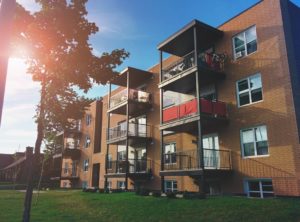 It’s no secret that housing costs are out of control in Tacoma. Like many urban areas, Tacoma is facing an influx of new residents (some priced out of more expensive markets, others simply drawn to the appeal of our hometown). However, as Tacoma’s neighborhoods are:
It’s no secret that housing costs are out of control in Tacoma. Like many urban areas, Tacoma is facing an influx of new residents (some priced out of more expensive markets, others simply drawn to the appeal of our hometown). However, as Tacoma’s neighborhoods are:
a. Largely built-out, and
b. Anything except single family-only housing is illegal,
…this has the effect of lowering vacancy rates and driving up both rent and sale prices.
Here in North Tacoma, this has driven the median home sale price up an astounding $95,000 higher in just one year ($600,000 now), while the average North End 2 bedroom apartment escalated over $460 higher per month in rent (almost $2,000 now) in that same period of time. Both trends are clearly unsustainable. There is literally no path to curbing extreme housing price increases that does not involve increasing the supply of housing inventory.

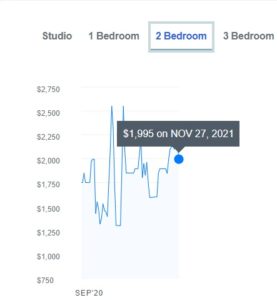
 Thankfully, city leadership agrees. As part of a multi-year policy-making process, the City of Tacoma and Planning Commission undertook an extensive program called “Home in Tacoma” to expand housing choices throughout our city. What this means, plainly, is simplifying the zoning code for residential areas. Instead of an alphabet soup of R1, R2, R3, etc. – all with subtle and often unpredictable nuances – residential zoning will now be simply one of two categories: Low-Scale Residential or Mid-Scale Residential.
Thankfully, city leadership agrees. As part of a multi-year policy-making process, the City of Tacoma and Planning Commission undertook an extensive program called “Home in Tacoma” to expand housing choices throughout our city. What this means, plainly, is simplifying the zoning code for residential areas. Instead of an alphabet soup of R1, R2, R3, etc. – all with subtle and often unpredictable nuances – residential zoning will now be simply one of two categories: Low-Scale Residential or Mid-Scale Residential.
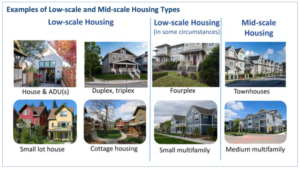 The vast majority of residential neighborhoods (light yellow on the map) will be designated as Low-Scale. This will allow for single-family housing, detached accessory dwelling units, cottage housing, and up to triplexes (fourplexes or small multi-family will be allowed in certain areas with a conditional use permit). Mid-Scale neighborhoods (orange on the map) will allow all of those uses too, but will also permit more townhouses and medium-scale multi-family as well. Mid-Scale Residential is primarily oriented around major transit corridors like N 21st St, N I St, Union Ave, and 6th Ave, and as a “missing middle” buffer around mixed-use centers like Proctor or Westgate.
The vast majority of residential neighborhoods (light yellow on the map) will be designated as Low-Scale. This will allow for single-family housing, detached accessory dwelling units, cottage housing, and up to triplexes (fourplexes or small multi-family will be allowed in certain areas with a conditional use permit). Mid-Scale neighborhoods (orange on the map) will allow all of those uses too, but will also permit more townhouses and medium-scale multi-family as well. Mid-Scale Residential is primarily oriented around major transit corridors like N 21st St, N I St, Union Ave, and 6th Ave, and as a “missing middle” buffer around mixed-use centers like Proctor or Westgate.
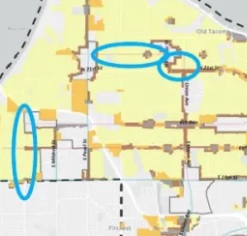 Before the final City Council vote, three corridors in the North End were down-zoned from the originally-proposed Mid-Scale designation back to Low-Scale: part of the N Union Ave corridor, part of S Jackson Ave, and N 26th St between Westgate and Proctor.
Before the final City Council vote, three corridors in the North End were down-zoned from the originally-proposed Mid-Scale designation back to Low-Scale: part of the N Union Ave corridor, part of S Jackson Ave, and N 26th St between Westgate and Proctor.
Now…when will this all really take effect? Not immediately. The city still needs to implement the “Phase 2” portion of Home in Tacoma in early 2022. This will involve the actual re-zoning of the neighborhoods, and some of the particulars are somewhat subject to change.
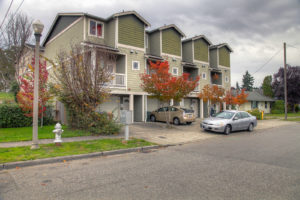 But over the long term, does this have the potential to be transformative? Absolutely. For decades, the division between multifamily neighborhoods and single family-only neighborhoods was a very deliberate policy decision designed to segregate housing, and to concentrate home ownership among whites. If you’ve ever wondered why the North End is lily-white compared to other parts of town, that’s largely the reason. Besides beginning the long process of helping remedy a legacy of housing discrimination, greater housing choice means just that – choice. People who want to age in place, or supplement their mortgage with rental income, will have greater opportunities for doing so. And of course, the main reason: tackling the housing shortage means less obscene rates of price increases.
But over the long term, does this have the potential to be transformative? Absolutely. For decades, the division between multifamily neighborhoods and single family-only neighborhoods was a very deliberate policy decision designed to segregate housing, and to concentrate home ownership among whites. If you’ve ever wondered why the North End is lily-white compared to other parts of town, that’s largely the reason. Besides beginning the long process of helping remedy a legacy of housing discrimination, greater housing choice means just that – choice. People who want to age in place, or supplement their mortgage with rental income, will have greater opportunities for doing so. And of course, the main reason: tackling the housing shortage means less obscene rates of price increases.
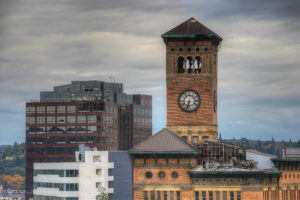 As I have stated before: multi-family development is not the enemy of single-family neighborhoods. The fundamentals of a neighborhood that attract multi-family development to begin with usually make the area more desirable, not less. (Hence why Proctor commands a $60,000 premium compared to the North End as a whole, even after both apartment buildings were constructed.) It will truly take an “all of the above” approach to bring greater housing security to all Tacomans. Home in Tacoma is far from perfect, but it’s a great start.
As I have stated before: multi-family development is not the enemy of single-family neighborhoods. The fundamentals of a neighborhood that attract multi-family development to begin with usually make the area more desirable, not less. (Hence why Proctor commands a $60,000 premium compared to the North End as a whole, even after both apartment buildings were constructed.) It will truly take an “all of the above” approach to bring greater housing security to all Tacomans. Home in Tacoma is far from perfect, but it’s a great start.